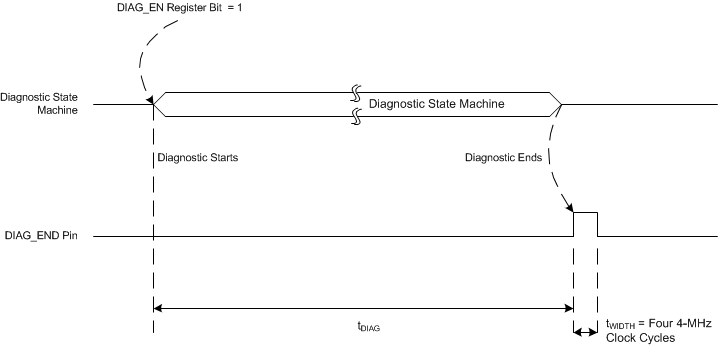SBAS650C May 2014 – April 2021 AFE4403
PRODUCTION DATA
- 1 Features
- 2 Applications
- 3 Description
- 4 Revision History
- 5 Device Family Options
- 6 Pin Configuration and Functions
- 7 Specifications
- 8 Detailed Description
- 9 Application Information Disclaimer
- 10Power Supply Recommendations
- 11Layout
- 12Device and Documentation Support
- 13Mechanical, Packaging, and Orderable Information
Package Options
Mechanical Data (Package|Pins)
- YZP|36
Thermal pad, mechanical data (Package|Pins)
Orderable Information
8.4.2.3 Diagnostics Module
The diagnostics module, when enabled, checks for nine types of faults sequentially. The results of all faults are latched in 11 separate flags.
The status of all flags can also be read using the SPI interface. Table 8-7 details each fault and flag used. Note that the diagnostics module requires all AFE blocks to be enabled in order to function reliably.
| MODULE(1) | SEQ. | FAULT | FLAG1 | FLAG2 | FLAG3 | FLAG4 | FLAG5 | FLAG6 | FLAG7 | FLAG8 | FLAG9 | FLAG10 | FLAG11 |
|---|---|---|---|---|---|---|---|---|---|---|---|---|---|
| — | — | No fault | 0 | 0 | 0 | 0 | 0 | 0 | 0 | 0 | 0 | 0 | 0 |
| PD | 1 | Rx INP cable shorted to LED cable | 1 | ||||||||||
| 2 | Rx INN cable shorted to LED cable | 1 | |||||||||||
| 3 | Rx INP cable shorted to GND cable | 1 | |||||||||||
| 4 | Rx INN cable shorted to GND cable | 1 | |||||||||||
| 5 | PD open or shorted | 1 | 1 | ||||||||||
| LED | 6 | Tx OUTM line shorted to GND cable | 1 | ||||||||||
| 7 | Tx OUTP line shorted to GND cable | 1 | |||||||||||
| 8 | LED open or shorted | 1 | 1 | ||||||||||
| 9 | LED open or shorted | 1 |
Figure 8-33 shows the timing for the diagnostic function.
 Figure 8-33 Diagnostic Timing Diagram
Figure 8-33 Diagnostic Timing DiagramBy default, the diagnostic function takes tDIAG = 16 ms to complete. After the diagnostics function completes, the AFE4403 filter must be allowed time to settle. See the Electrical Characteristics for the filter settling time.